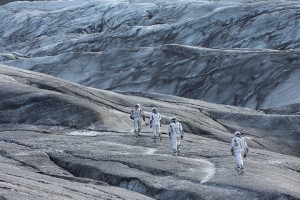
Associated Press
By Sean Cordy
Contributor
Director Christopher Nolan has often said that he won’t make something unless it’s completely original.
“Interstellar” certainly speaks with volume to that, acting as a sprawling, yet intimate, exploration of space and the human condition.
We’re introduced to the future world of “Interstellar” by the use of what seems to be archival footage that tells us how poor the ecosystem has become – nothing but a great dust bowl. We meet Matthew McConaughey’s character, Cooper, and his family in a future that seems to take us back in time. After some supernatural events in Cooper’s house that turn into a puzzle leading him to NASA, we are told there’s research being done to find a new home for humanity and that, though we were born here, we never meant to die here.
This is where Cooper reaches an impasse: He must leave his family to sustain human existence on a new planet by searching on the other side of a distant wormhole. It’s the heart of the film. Though it’s about the exploration of space and pushing the boundaries with technology, the film is really a deep exploration of relationships and how we deal with time’s threat to our existence.
The film’s ingenuity is inspired by works from the likes of Stanley Kubrick and Steven Spielberg, exposing its audience to a barrage of emotions. Like the previous directors named, Nolan uses the film’s high concepts, rather than the entire scope of the film, as a launching pad.
“Interstellar” takes a perhaps faulty approach to storytelling in its reliance on exposition in addition to its visuals that creates redundant and often convoluted messages. Excessive exposition has often been a fault in Nolan’s films, and it’s most apparent here. The more his characters talk or narrate, the more they distract from the story and miscommunicate with the audience.
That’s not to say that the dialogue is inherently bad, just overused. It also overshadows the astonishing IMAX-deserving images that appear in the film.
Ultimately, what’s beneath all of the talk is emotionally and intellectually intriguing. “Interstellar” examines how time eventually draws the curtain on the show. However, through the theories of Kip Thorne, the film shows us that through different dimensions and various manipulations, we can alter time to reformat and save the future. These theories are all the more realized by the phenomenal visual effects, and the cinematography that often has a blown out tone to resemble a continued hope for survival.
While watching “Interstellar,” it’s important to try and allow the emotions of the film sweep you – don’t get caught up in the technical dialogue, because the film’s themes are being presented to you in a magnificent manner on screen already. If you try to process all of the theories present, you’ll likely miss some very emotional moments like McConaughey witnessing his children grow up, or Michael Caine’s character admitting his faults to a terrific Jessica Chastain, and so forth.
The cast is in fine form, and the best Nolan has ever assembled – all sewn together by tantalizing music from Hans Zimmer that perfectly catches the ebb and flow of the film.
There are certainly some questionable moments throughout “Interstellar,” but most of the scenes help the film in the end. It’s a technical feast for the eyes and ears, and stimulates your soul more than any other Nolan film before, but its hand holding of the audience lessens the overall impact. Just be sure not to let your first impressions after the credits roll predicate your impression of the film. Let the experience settle in first.




